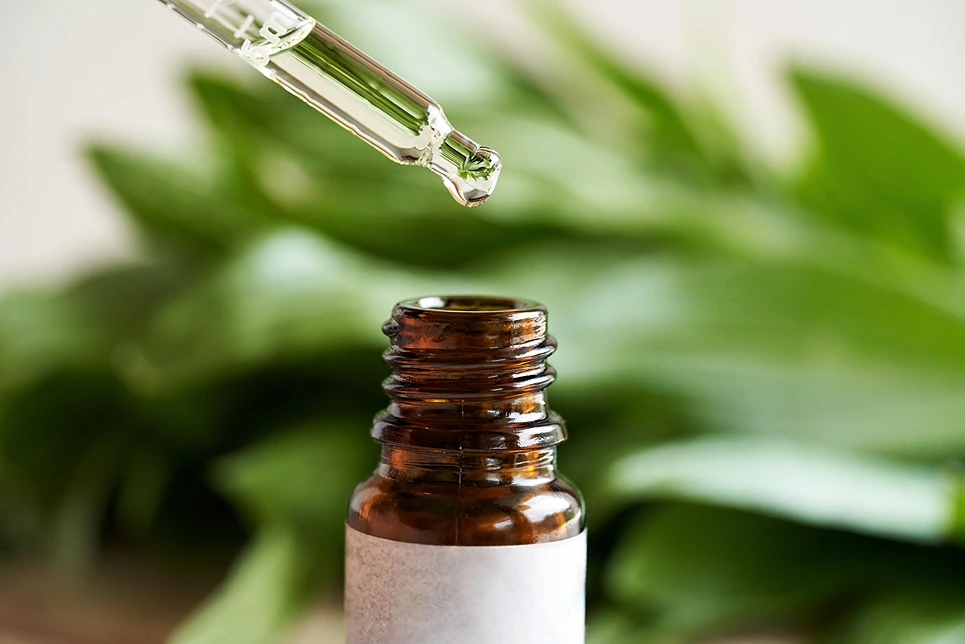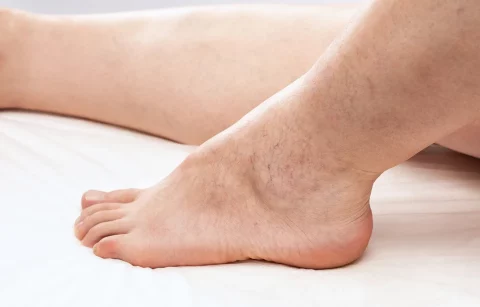Explore the Potential Benefits of Aromatherapy for Improving Spider Vein Symptoms

Some essential oils like cypress, geranium, and lavender may help improve the appearance of spider veins. You can blend these oils together and apply them topically to areas with spider veins.
Spider veins are small, thin veins that lie close to the surface of the skin. Also known as thread veins or broken capillaries, they typically appear on the legs as blue, red, or purple web-like networks. While spider veins are harmless, many people seek treatment for cosmetic reasons or to find relief from symptoms like aching, burning, swelling, and night cramps.
Certain essential oils may help improve the appearance and symptoms of spider veins when used topically. Essential oils are highly concentrated extracts derived from plants that contain active compounds. Some oils, like cypress and rosemary, have traditional uses for promoting circulation and soothing skin.
While essential oils should not replace medical treatment, using them as part of a regular skin care routine could provide natural support for spider veins.
What Causes Spider Veins?
Spider veins often develop due to weak vein valves and blood vessels or increased pressure in the veins. Contributing factors include:
- Genetics
- Pregnancy
- Weight gain
- Aging
- Long periods of standing or sitting
- Hormone changes
- Previous blood clots
- Sun exposure
Women tend to develop spider veins more frequently than men, especially during pregnancy and menopause. Spider veins can worsen over time and may be accompanied by symptoms like aching, throbbing, muscle fatigue, and itching.
While not usually medically concerning, many people opt for spider vein treatment to reduce discomfort, improve appearance, or prevent progression to varicose veins.
Schedule a free consultation with The Vein Doctor to receive a medical assessment identifying the root causes of your spider veins
Can Essential Oils Help With Spider Veins?
While there’s limited scientific research on essential oils for spider veins specifically, some oils may help based on their traditional uses and anecdotal evidence. Certain oils contain compounds that promote circulation, reduce inflammation, and improve skin health – all of which could benefit spider veins.
For example, oils like cypress and rosemary have astringent and antispasmodic properties. This means they may improve blood flow and strengthen vein walls when applied topically. Chamomile, geranium, and lavender oils contain anti-inflammatory compounds that could relieve swelling and discomfort. Carrier oils like jojoba and coconut nourish the skin to improve spider vein appearance.
However, most claims around essential oils for spider veins rely on historical use in aromatherapy rather than clinical trials. More research is still needed to conclusively prove their benefits. Essential oils should complement spider vein treatment, not replace medical procedures prescribed by your doctor. Manage expectations and use them as part of a holistic approach.
With realistic expectations, using essential oils could provide natural circulation support, ease achiness, reduce inflammation, and make spider veins less visible. Certain oils may relieve symptoms enough to delay the need for invasive treatments.
Essential Oils for Improving Spider Veins

Here are some top essential oils for spider veins based on traditional use and skin-healing benefits:
Lavender Oil
Lavender essential oil encourages healthy circulation and blood flow when massaged into the skin. It also provides anti-inflammatory, antiseptic, and pain-relieving effects that can help soothe spider vein discomfort. The soothing scent of lavender is perfect for winding down before bed after a long day on your feet.
Cypress Oil
Cypress oil has astringent properties that promote circulation and may strengthen weak vein walls over time. This constricting effect helps tighten and firm the skin, potentially reducing the appearance of spider veins. Cypress also has antimicrobial properties to ward off infection. Use it blended with a carrier oil like jojoba.
Geranium Oil
Like lavender, geranium oil offers anti-inflammatory and antiseptic properties in addition to promoting circulation. It encourages blood flow while soothing swelling and skin irritations. The floral scent of geranium uplifts the mood to combat spider vein discomfort.
Rosemary Oil
Rosemary is known for boosting circulation and supporting vein health. It contains antioxidant compounds like rosmarinic acid that offer anti-inflammatory benefits. When diluted and applied topically, rosemary oil may minimize the appearance of broken capillaries over time.
Ylang Ylang Oil
Sweet, floral ylang ylang oil is said to promote relaxation and calm the mind when inhaled or used during massage. This can help ease stress that exacerbates spider vein symptoms. Ylang ylang also supports healthy circulation. Use it in blends or add a few drops to a warm bath.
Chamomile Oil
The anti-inflammatory compounds in chamomile oil called chamazulene provide soothing relief for irritated skin and the discomfort of spider veins. Chamomile also promotes circulation and relaxation. Enjoy its mild, herbaceous scent before bedtime or add it to creams.
Always dilute essential oils properly before applying them to the skin, especially if you have sensitive skin.
Ask The Vein Doctor which essential oil blends may provide natural relief for your spider vein discomfort when used alongside medical treatment
Essential Oil Blend Recipes for Spider Veins
Here are a few blend ideas to get you started making customized essential oil remedies for spider veins:
1. Soothing Skin Salve Blend
This simple blend combines the soothing benefits of lavender and chamomile to ease irritation, inflammation, and discomfort from spider veins. Jojoba oil nourishes and moisturizes skin. Massage it onto affected areas like legs and feet nightly before bed.
Ingredients are:
- 3 drops lavender essential oil
- 3 drops chamomile essential oil
- 1 tbsp jojoba oil
2. Invigorating Massage Blend
Coconut oil moisturizes while the essential oils promote circulation and help strengthen veins and capillaries when massaged into the legs. For best results, use this invigorating blend in the mornings after showering. Mix the following:
- 2 drops cypress essential oil
- 2 drops rosemary essential oil
- 2 drops geranium essential oil
- 1 tbsp coconut oil
3. Anti-Inflammatory Compress Blend
Soak a clean cloth in this blend diluted in warm water. Apply the compress to spider veins to reduce inflammation and discomfort. The relaxing aromas also unwind tension. Reheat the cloth and reapply as needed.
- 3 drops lavender essential oil
- 3 drops ylang ylang essential oil
- Bowl of warm water
Always blend essential oils with a base of carrier oils like jojoba, coconut, or avocado oil before applying to skin. This helps evenly distribute and dilute the oils to prevent sensitivity. For compress blends, mix 3-5 drops of essential oil per cup of water.
How to Apply Essential Oils for Spider Veins

Essential oils can help improve the appearance of spider veins when applied topically over time. By following some key steps, you can properly dilute and apply essential oils to target spider veins and enhance circulation in the legs.
- Choose the right essential oils. Some of the best essential oils for spider veins and varicose veins include lavender, lemongrass, cypress, rosemary, and tea tree oil.12
- Dilute the essential oils before applying. Mix 3-5 drops of the essential oil with 2-3 tablespoons of a carrier oil like coconut, olive, or sweet almond oil. This helps dilute the potent essential oils and prevent skin irritation.13
- Apply the oil blend directly to the affected area. Gently massage the oil mixture into the skin over the spider veins using circular motions. This can help improve circulation and reduce the appearance of the veins.45
- Use a warm or cool compress. You can soak a clean cloth in the essential oil blend and apply it as a warm or cool compress to the area. This can help increase absorption of the oils.46
- Be consistent with application. For best results, apply the essential oil blend 1-2 times per day, such as in the morning and evening. Continue using it regularly over several weeks.
- Avoid excessive sun exposure when using oils as many increase sun sensitivity. Apply sun protection if spending time outdoors.
- Take extra care when using oils during pregnancy, for children, or if you have sensitive skin. Always do a patch test beforehand.
Proper dilution and application allows the beneficial compounds in essential oils to penetrate the skin and support vein health.
Schedule an appointment with The Vein Doctor today to discuss advanced medical procedures that can permanently remove spider veins
Professional Spider Vein Treatments
If over-the-counter options like essential oils provide limited relief for your spider veins, several medical procedures can remove them permanently. Popular spider vein treatment options include:
Sclerotherapy
This is the most common treatment, where a solution is injected directly into the veins to scar and close them off. The collapsed veins are then reabsorbed by the body, causing the spider veins to fade within 3-6 weeks.
Laser Therapy
A non-invasive option where laser heat damages the vein walls to close them off. The collapsed vein is eventually reabsorbed by the body.
VenaSeal
A non-thermal, non-tumescent procedure that uses medical adhesives to close off damaged veins. A catheter is inserted and adhesive is dispensed directly inside the vein to seal the walls shut.
Venous Compression Therapy
Flexible wraps are applied from the foot to knee to improve circulation and reduce pressure in veins, which can help shrink and fade spider veins over time.
These treatments are typically performed by dermatologists or plastic surgeons and can effectively remove spider veins, often with minimal downtime. Lifestyle changes like exercise, weight management, and avoiding prolonged sitting or standing can also help prevent new spider veins from forming.
Always discuss the pros and cons of each method with your dermatologist or vein specialist. They can help decide the best course of treatment based on the specifics of your case.
Conclusion

Using essential oils may provide mild benefits for spider veins when used regularly, but should not replace medical treatment. If you’re looking to reduce discomfort, improve appearance, or diminish spider veins, be sure to consult your doctor about safe and effective treatment options.
The Vein Doctor offers customized treatment plans to reduce the appearance of spider veins and improve your comfort. Their experienced vein specialists can assess your symptoms, diagnose any underlying causes, and recommend the best solutions for your needs.
Don’t wait to take action on troublesome spider veins – contact The Vein Doctor today to schedule your consultation and get on the path to clearer, healthier looking legs.







